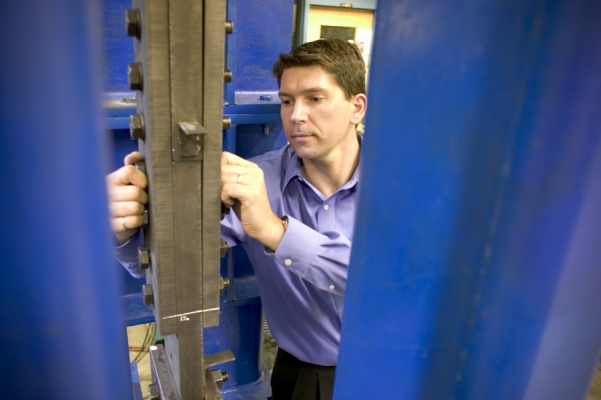Researcher helping Oregon's transportation network withstand quake like Japan's

As a student at the University of British Columbia, Peter Dusicka pursued earthquake engineering in part because so few others had taken that path. “I was looking for a way to make a difference and looking for areas within civil engineering that seemed immature,” Dusicka said.
There was too much guesswork as to how well the Pacific Northwest’s transportation network would handle the type of subduction zone earthquakes the region is prone to. Now, thanks in part to Dusicka’s research, we know a lot more.
When it comes to the fragility of Oregon’s transportation system, the recent earthquakes around the Pacific Rim provide more insight into a major quake than do models developed for North America, said Dusicka an OTREC researcher and Portland State University associate professor. “The subduction zone earthquake in Oregon, Washington and British Columbia isn’t a threat anywhere else in the U.S.,” he said.
The recent Japanese quake as well as the one in Chile—both subduction-zone quakes—are more instructive. Subduction-zone quakes tend to be larger magnitude, shake longer and affect a larger geographic area than other earthquakes.
The serious earthquake related damage in Japan probably would have been worse had that country’s leaders not been spurred by the 1995 Kobe earthquake. “The Japanese people and government learned quite a bit from that event and reacted strongly,” Dusicka said.
“They’ve made significant investments in earthquake research. They have some of the newest facilities. The largest shake table in the world is there as a result.”
In Oregon, it’s not just the earth shaking that is different; the typical bridge is also different than bridges previously studied for earthquake resilience. Taken together, that means the broad earthquake damage models don’t provide the most useful picture for what would actually happen in Oregon.
In an OTREC research project, Dusicka examined Oregon’s bridges and found that the existing damage model would underestimate the effects of a major earthquake in the state. “Our bridges are more fragile than the national model (indicates),” he said, because of how the bridges were designed and built before the 1980s.
“We didn’t have a good sense of the risk,” Dusicka said. “And we didn’t know how to design effectively then.”
Dusicka simulated earthquake effects on the Oregon highway bridge inventory. He found that many bridges would either collapse or sustain heavy damage..jpg) (Download the draft report.)
(Download the draft report.)
Now that transportation officials know how vulnerable Oregon’s bridges are, the next question is what to do about it. With Dusicka’s research lighting the way, the Oregon Department of Transportation committed to a seismic retrofit research project for bridges.
But which bridges? There isn’t enough money to replace or even retrofit every highway bridge built before 1980, so state officials need to be selective. In his current OTREC project, Dusicka is creating a system to prioritize bridge retrofits. This system will take into account the cost and benefit of bridge retrofits to highway segments and will consider entire routes.
Some bridges are more strategically important than others because of the commercial traffic they carry or their location, Dusicka said. “If (Interstate) 5 goes, what is your next alternative?” he said. “It’s likely a 500-mile detour.”
Bridge design standards can prevent catastrophic failures, Dusicka said, but it’s a long way from making bridges earthquake proof. “People think that the seismic design for current standards will be just fine in an earthquake.
“It will be fine in that it won’t kill you, but is it usable? That’s a different question.”
Prioritizing bridges to receive retrofits is just one step toward the goal of creating a safer, less fragile transportation network, Dusicka said. The next step is getting the retrofits right.
In some ways, earthquake engineering is still an immature field, Dusicka said. While engineers know how to design a new bridge to withstand an earthquake, they don’t fully understand how a retrofitted bridge will perform. “We still haven’t asked how vulnerable they are after the retrofit,” Dusicka said.
“We haven’t answered ‘What is an effective retrofit for us here in Oregon?’ “
